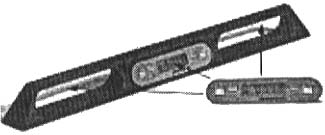Smart Level
![]()
Smart Level |
|
by Richard Clements
This appeared in the March 1992 issue of the Falco Builders Letter. When he is not building his Falco, Richard Clements is busy at his printing business in Denver. Since getting this device, Richard has become compulsive about things being level, and he even parts his hair in the middle. |
I want to tell you about a tool that has been a blessing for me and a lot of others, the SmartLevel digital inclinometer. This is a digital carpenters level made in two pieces: there's a sensor module that houses all the electronic guts, and you can use this by itself or snap it into a variety of handsome triangular aluminum-and-teak rails.
The sensor reads out the angle to a tenth of a degree, and there are several display modes: degrees-of-slope, inches-per-foot rise-over-run, percent-of-slope, and a simulated electronic bubble display. The module alone cost $86.00, and I did not buy the rail. This little cutie is made by Wedge Innovations, 532 Mercury Drive, Sunnyvale, California 94086, and is sold through many woodworking catalogues.

What enticed me to spend the money for it was a presentation at my EAA Chapter by a local fellow who sells it. He is retired and was looking for something to do. He stumbled across the level and is now having a ball. One of the uses for the level that he 'invented' was for Formula 1 racing. The crews take an enormous amount of time determining the best angle for the front wing. If there is any small wing-angle change in the race due to a bump, it is impossible to reset it precisely.
He went to a car, located a substantial frame member in the same plane as the wing and took a reading of the member. He then took a reading of the wing. Now, he had a degree differential between the two. Then, to the horror of the crew, he kicked the wing-which of course knocked it out of adjustment. (Keep in mind that the adjustment was the result of hours of actual driving and adjusting.)
The crew threatened to lynch him. He told them to drive the car once around the track and return it. He would then adjust the wing to the exact level as before his booting it. They did, and he did. They were amazed and bought the level on the spot. No more adjusting problems. This, he claims, became a racing secret for a while until other crews saw what was happening. He sold a bunch as a result.
He also tells a story about submarines, but I will forgo that one.
I thought about the leveling possibilities in building a Falco and bought one on the spot. The most recent use of the level was constructing the mold for the cowling. How can one be certain the cooling inlets are parallel to the plane of the wing? Simple. Lay a bar across the canopy rails and take a reading. Then transpose that reading to the flat plate bolted to the crankshaft flange. This plate is the form for the propeller/spinner match-up to the cowling. Clamp a piece of angle iron to the plate with the same degree reading as taken on the canopy rails. You now have parallel planes and can sight in the cooling inlets.
The possibilites for wing, fuselage, etc. construction are enormous. I wish I had it back when I was building. It would have done away with plumb bobs and all the other gyrations I did to insure parallelism, etc.
The only problem with the level is its one-tenth-of-a-degree exactness. You can spend too much time trying to obtain a tenth of a degree when before you would have been ecstatic to be within the meniscus of a bubble, which was probably a degree or so. I have especially encountered this problem in constructing things around the house.
Now, if all problems were of this nature, life would be like finding a bucket of money!